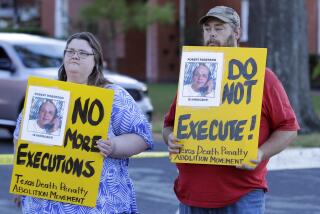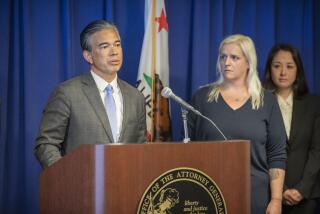Court Hears Bid to Let Man Die
- Share via
SAN FRANCISCO — In a pivotal right-to-die case, the California Supreme Court appeared reluctant Wednesday to permit a Stockton woman to remove a feeding tube from her severely brain-damaged, but conscious, husband.
The court heard arguments in the case of Robert Wendland, a 49-year-old who suffered extensive brain damage in a 1993 car accident. He cannot speak, eat, walk, go to the bathroom or communicate by blinking his eyes or using machinery.
His wife and three children want to remove a tube that gives him food and water, so he can die.
Wendland’s mother wants him to live and has fought her daughter-in-law in court since 1995.
The case has drawn wide national attention because it may determine the future for thousands of patients who are conscious but who are so profoundly brain-damaged that they cannot recognize loved ones or communicate.
The state high court will decide the case, Conservatorship of Wendland, S087265, within 90 days.
On Wednesday, several justices dwelt on the fact that Wendland is conscious and not in a truly vegetative state. He can respond to simple commands but shows no signs of being able to comprehend more. Doctors say he could live this way for decades.
In previous cases, courts nationwide have allowed the withdrawal of feeding tubes only from patients who were in a vegetative state, such as a coma, or were terminally ill.
Janie Hickok Siess, an attorney for Wendland’s mother, Florence Wendland, 78, repeatedly told the court that Robert has cognitive ability and can interact with his environment.
“Robert thinks and Robert feels,” Siess said. “. . . He still has cognitive function, and that’s where the line has to be drawn.”
Lawrence J. Nelson, the lawyer representing Wendland’s wife, Rose, stressed the severity of the impairment.
A Superior Court judge who first heard evidence in the case decided that Wendland “was not cognitive,” Nelson told the court. “He cannot respond to others.”
Chief Justice Ronald M. George did not seem persuaded by Nelson. “He can respond to some questions . . . move a peg to show ‘yes’ or ‘no’ and catch a ball,” George observed.
Three of the court’s seven justices referred to a series of questions Wendland was asked several years ago in therapy using “yes” and “no” blocks.
When asked if his name was Robert, he indicated “yes.” When asked if his name was Michael, he indicated “no.” When asked if he wanted to be left alone, he used the “yes” block. When asked if he wanted to die, he did not respond.
“That to me shows ambivalence,” said Justice Joyce L. Kennard.
She said that people have a constitutional right to life and that the state has an interest in preserving life. If new evidence emerged about Wendland’s wishes in the matter, his wife could go back to court to get his feeding tube removed, Kennard suggested.
Lawyers for the Wendlands and their medical experts say Robert’s responses to such “yes” and “no” questions were inaccurate 50% of the time. They were asked in therapy that has since been discontinued.
The medical experts hired by Wendland’s wife maintain that Robert can respond only if he is cued and coached heavily, not unlike a dog that is trained.
At issue is a state law that allows conservators to withdraw feeding tubes from loved ones who cannot express their own wishes. The court is grappling with the standard of evidence it should apply before nutrition and water can be terminated.
Although the justices did not clearly state which standard they favor, they spoke frequently of requiring “clear and convincing” evidence that the patient would have wished to die and that death would be in the patient’s best interest.
George expressed concern that without some sort of strict requirement, conservators could easily remove life support from patients who are fully cognitive but unable to communicate.
When an attorney for Robert Wendland replied that this case is different, George noted that a ruling from the court would be applied broadly to many cases.
Before his accident, Robert Wendland told his wife and brother that he would not want to be kept alive on life support or to live if he became a “vegetable.”
“Didn’t those remarks focus more on being in a truly vegetative state, which we all agree is not Robert’s condition?” George asked.
Jon Eisenberg, who represented bioethicists before the court, said most people don’t distinguish a persistent vegetative state, such as a coma, from the kind of minimally conscious condition of Robert. Eisenberg supports Rose Wendland in the case.
Conflicts like those facing the Wendlands could be avoided if people put their wishes in writing before they were injured, Justice Marvin Baxter said.
If the court made it relatively easy for people to remove feeding tubes from disabled loved ones, wouldn’t it discourage them from putting their wishes in writing? he asked.
Eisenberg replied that “people don’t think about what courts are going to require them to prove.”
Lawyers for Rose Wendland said only about 10% to 20% of U.S. citizens leave written instructions about health care matters.
Nelson said after the arguments that the court appeared to misunderstand Wendland’s level of awareness.
“I was surprised by some of the justices’ questions,” Nelson said. “I don’t think they understand Robert’s true condition.”
James M. Braden, Wendland’s court-appointed lawyer, agreed. “They’re almost toying with the idea that he is still competent,” he said.
Braden visited Robert Wendland two weeks ago. “He certainly has no cognitive awareness of his environment,” he said.
Siess, the mother’s lawyer, said she was pleased with the court’s reaction to the arguments.
Rose Wendland expressed frustration that the legal case remains unresolved.
“It never should have gone this far,” she said. “Just because someone has birthed someone does not give them the right.”
Rose, her husband’s brother and children said he left home at an early age and had been estranged from his mother for several years before the accident.
More to Read
Get the L.A. Times Politics newsletter
Deeply reported insights into legislation, politics and policy from Sacramento, Washington and beyond. In your inbox three times per week.
You may occasionally receive promotional content from the Los Angeles Times.











